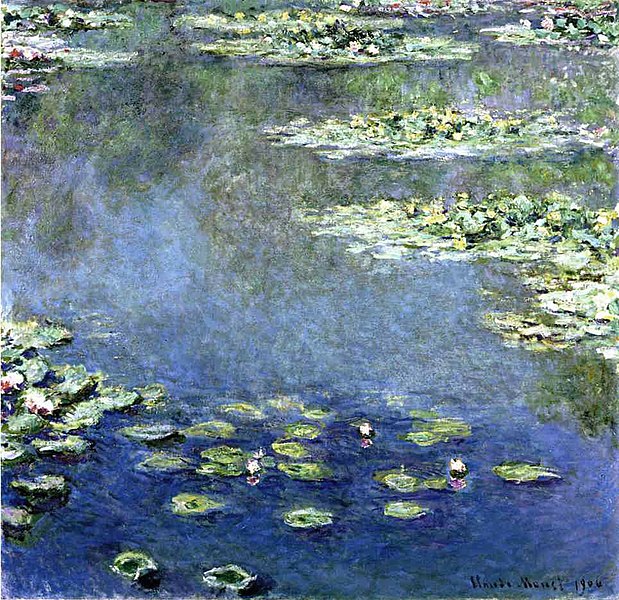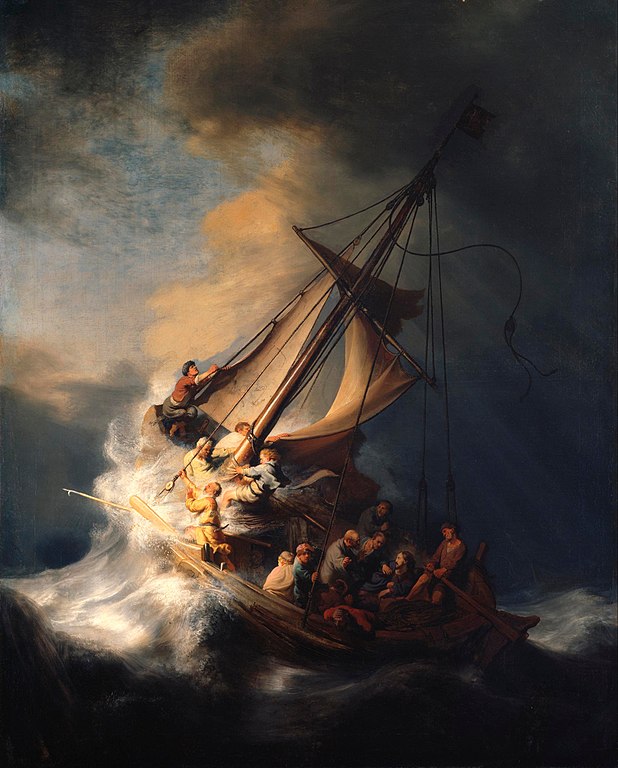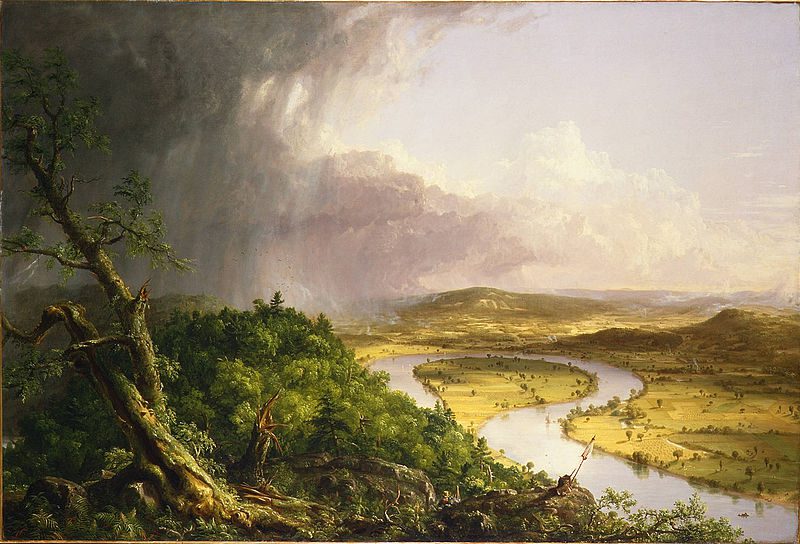20 Famous Landscape Paintings That Will Take Your Breath Away
Step into a world where nature’s beauty dances on canvas, capturing the essence of breathtaking landscapes. In this article, we unveil a collection of 20 famous landscape paintings that will leave you spellbound. Each stroke of the artist’s brush unveils a narrative, transporting you to serene meadows, majestic mountains, and tranquil seascapes. As we journey through time, t masterpieces that have stood the test of time captivate. From the ethereal landscapes of Claude Monet to the rugged wilderness of Albert Bierstadt. All these paintings encapsulate the beautiful wonders of our planet. The beauty of nature is frozen as seen through the eyes of these visionary artists. Continue reading to learn the secrets and stories behind these remarkable works of art. Discover why they continue to inspire and take our breath away.
1. “The Starry Night” – Vincent van Gogh

Vincent van Gogh, Public domain, via Wikimedia Commons
With its depiction of a nocturnal sky adorned with swirling stars and a radiant moon, the artwork unveils a dreamlike scene that seems to transcend reality. Van Gogh’s used fearless and vigorous brushstrokes, combined with his skillful use of vibrant colors. They add to the piece a palpable sense of motion and depth, enticing the observer to become immersed in its captivating atmosphere. The Starry Night is van Gogh’s distinctive artistic style marked by his ability to convey profound emotions through his creations. Each stroke of the brush reflected van Gogh’s inner turmoil and desire to capture the essence of the natural world on canvas. This artwork uncovers a myriad of interpretations and personal connections.
Practical Information
Year: 1889
Artistic Period: Post-Impressionism
Medium: Oil on Canvas
Art: 15 Most Famous Portraits.
2. “The Hay Wain” – John Constable

John Constable, Public domain, via Wikimedia Commons
John Constable, one of the most celebrated landscape painters in art history, gifted the world with his exquisite masterpiece titled The Hay Wain. This painting is the epitome of picturesque beauty. The idyllic essence of the English countryside in all its glory is captured. “The Hay Wain” transports us to a serene realm, where a horse-drawn wagon gracefully traverses a shallow river. The scene is awash with a vibrant palette of colors, revealing nature’s bounty in every brushstroke.
Lush greenery embraces the riverbanks, exuding a sense of vitality and tranquility. Above, a sky of serene blues and fluffy clouds completes this harmonious tableau. Constable’s meticulous attention to detail is evident throughout the painting. The artist’s mastery in capturing the subtle nuances of nature is remarkable. Through his skilled hand, he has immortalized a fleeting moment of beauty in the English countryside.
Practical Information
Year: 1821
Artistic Period: Romanticism
Medium: Oil on Canvas
15 Most Famous Landscape Painters
3. “Water Lilies” Series – Claude Monet

Claude Monet, Public domain, via Wikimedia Commons
This extraordinary collection of landscape paintings transports viewers to a realm where the splendor of water and nature intertwine harmoniously. Monet’s masterpiece unfolds within the enchanting confines of his beloved garden nestled in the picturesque town of Giverny, France. With delicate precision, Monet meticulously captures the essence of this sanctuary, adorned with resplendent water lilies, their ethereal reflections dancing gently upon the water’s surface. Each stroke of Monet’s brush breathes life into the canvas.
It infuses it with vibrant colors that seem to radiate from within. The fluidity and spontaneity of his brushwork evoke a sense of movement. Monet’s masterful manipulation of light and atmosphere further enhances the immersive experience. The viewer becomes an active participant in the tranquil oasis he has created. The garden’s delicate nuances, invite us to pause, breathe, and find solace in the ethereal beauty that surrounds us.
Practical Information
Year: 1896-1926
Artistic Period: Impressionism
Medium: Oil on Canvas
4. “Wanderer above the Sea of Fog” – Caspar David Friedrich

Caspar David Friedrich, Public domain, via Wikimedia Commons
An incredibly captivating and intellectually stimulating artwork ever created undoubtedly is Wanderer above the Sea of Fog. This enthralling work of art by the renowned artist Caspar David Friedrich carries observers to a dimension of contemplation and fascination. The brushstrokes of Friedrich gracefully represent the fundamental nature of meditation and self-examination. The organizers encourage everyone to engage themselves within the canvas’s profound account. The lone traveler symbolizes the search of mankind for significance and bonding among the magnificent pattern of the environment.
Being at the edge, the person seems to seem both tiny and unimportant compared to the magnificent might of nature. Nevertheless, there is at this moment of weakness that individuals can genuinely admire the greatness and impressiveness of the outdoors. The performance of brightness and obscurity in Friedrich’s creation amplifies the theatrical impact. It imbues the piece with a spellbinding energy. This is like sunbeams cutting through the foggy curtain carrying the potential for exploration and understanding.
Practical Information
Year: 1818
Artistic Period: Romanticism
Medium: Oil on Canvas
5. “The Fighting Temeraire” – J.M.W. Turner

J. M. W. Turner, Public domain, via Wikimedia Commons
The Fighting Temeraire is an awe-inspiring masterpiece that seamlessly blends history and landscape, captivating viewers with its profound artistic expression. This remarkable painting by J.M.W. Turner is a poignant representation of the final voyage of the venerable HMS Temeraire, a majestic warship destined for dismantlement, symbolizing the conclusion of a glorious era. As one gazes upon this artwork, Turner’s genius becomes palpable through his exquisite manipulation of light, a hallmark of his unrivaled skill. The radiant hues of the sunset envelope the canvas, casting a golden glow over the scene and infusing it with an overwhelming emotional impact.
It is as if the fading sunlight tenderly embraces the Temeraire, illuminating its grandeur and commemorating its valorous past. With delicate brushstrokes and meticulous attention to detail, Turner conveys a sense of solemnity and reflection. The interplay between light and shadow creates a dramatic contrast, accentuating the ship’s imposing silhouette against the fading daylight. The careful composition of the painting guides the viewers’ gaze, drawing their attention to the focal point—the Temeraire, resplendent even in its final moments.
Practical Information
Year: 1839
Artistic Period: Romanticism
Medium: Oil on Canvas
6. “The Scream” – Edvard Munch

Edvard Munch, Public domain, via Wikimedia Commons
With its vivid orange sky and haunting expression, the central figure in the painting reaches out with outstretched hands, seemingly emitting a scream of anguish that resonates with viewers on a profound level. Munch’s deliberate use of bold colors and distorted forms further intensifies the emotional turmoil portrayed in this renowned artwork. As one gazes upon the twisted figure, it becomes impossible to escape the raw intensity of the depicted emotions, making The Scream an indelible and deeply impactful work of art.
Edvard Munch, a pioneer of Expressionism, poured his own inner turmoil into this piece. He drew upon personal experiences and universal themes of human suffering. Its visceral depiction of anguish and alienation has resonated with audiences across generations. Despite its age, the painting’s relevance persists in contemporary society. The artwork invites viewers to confront their own inner struggles and engage with the universal human experience.
Practical Information
Year: 1893
Artistic Period: Symbolism
Medium: Tempera and pastels on cardboard
30 Famous Portrait Painters that History Will Remember.
7. “Impression, Sunrise” – Claude Monet

Claude Monet, Public domain, via Wikimedia Commons
In the realm of art history, few works possess the transformative power and enduring influence that Claude Monet’s masterpiece, Impression, Sunrise, holds. As one gazes upon the enchanting canvas, they are transported to the serene port of Le Havre at the break of dawn. Monet’s deft strokes and visionary techniques imbue the artwork with a sense of ethereal beauty. The hazy atmosphere, delicately depicted through a myriad of soft, indistinct forms, mirrors the fleeting nature of light and color as they dance upon the canvas. “Impression, Sunrise” heralded a revolutionary departure from the traditional art practices of the time.
Monet dared to shatter the confines of precise detail, opting instead to focus on the essence and emotional impact of a scene. This audacious approach breathed new life into landscape painting, inviting viewers to embrace the subjective experience of art. His pioneering spirit paved the way for generations of artists to embrace their own interpretations, encouraging them to delve beyond the surface and explore the evocative power of light, color, and mood. The Impressionist movement flourished, forever altering the trajectory of artistic exploration.
Practical Information
Year: 1872
Artistic Period: Impressionism
Medium: Oil on Canvas
10 Reasons to Go to Monet’s house in Giverny
8. “The Great Wave off Kanagawa” – Katsushika Hokusai

Katsushika Hokusai, Public domain, via Wikimedia Commons
Katsushika Hokusai’s iconic masterpiece, The Great Wave off Kanagawa, stands as a renowned symbol of Japanese artistry. Crafted through the delicate technique of woodblock printing, this artwork portrays an imposing wave on the verge of engulfing a fleet of boats. All is set against the majestic backdrop of Mount Fuji. The sheer dynamism of the composition and attention to detail and the vibrant hues employed, reveal Hokusai’s profound technical prowess. It captures the raw force and breathtaking splendor of nature within the confines of a two-dimensional plane.
“The Great Wave off Kanagawa” effortlessly evokes a sense of awe and admiration, its surging wave becoming an emblem of untamed power. Hokusai masterfully plays with the interplay of light and shadow, skillfully capturing the play of sunlight upon the frothing waves and enhancing the intensity of the scene. Each element, meticulously etched onto the woodblock, tells a story, conveying the harrowing struggle of the tiny vessels against the colossal might of nature.
Practical Information
Year: 1830-1833
Artistic Period: Ukiyo-e
Medium: Woodblock print
9. “View of Toledo” – El Greco

El Greco, CC0, via Wikimedia Commons
El Greco’s View of Toledo captures the essence of the Spanish city. This remarkable landscape painting showcases the distinctive style of El Greco, renowned for his unconventional artistic techniques and innovative vision. El Greco’s distinct approach to perspective is one of the defining elements of this painting. He skillfully manipulates the proportions and placement of objects bending them to his artistic will instead of adhering strictly to traditional techniques.
The art transports to a realm where reality and imagination intertwine. The atmospheric treatment of light in “View of Toledo” further enhances the painting’s mysticism. El Greco masterfully employs chiaroscuro. Using stark contrasts between light and shadow to create a dramatic and almost otherworldly ambiance. The unique style, vibrant colors, and imaginative perspective draw us into a familiar and surreal world simultaneously.
Practical Information
Year: 1596-1600
Artistic Period: Mannerism
Medium: Oil on Canvas
10. “The Oxbow” – Thomas Cole

Thomas Cole, Public domain, via Wikimedia Commons
Thomas Cole’s The Oxbow is an exquisite masterpiece that encapsulates the breathtaking allure of the American wilderness. This captivating landscape painting transports viewers to the serene beauty of the Connecticut River Valley. Cole’s meticulous attention to detail, allows each element to come to life. As an eminent figure of the Hudson River School, Cole’s work embodies the movement’s core principles and aspirations. The romanticized portrayal of the landscape in “The Oxbow” captures its visual splendor. It also reflects the artists’ deep reverence for the untamed majesty of the American wilderness. Through skillful brushstrokes and a harmonious color palette, Cole invites viewers to experience the sublime power of nature.
Practical Information
Year: 1836
Artistic Period: Hudson River School
Medium: Oil on Canvas
11. “Mont Sainte-Victoire” Series – Paul Cézanne

Paul Cézanne, Public domain, via Wikimedia Commons
This collection of landscape paintings serves as a testament to Cézanne’s profound exploration of the sheer beauty and underlying geometry found in the majestic mountain situated in southern France. In his pursuit of representing this natural wonder, Cézanne ingeniously employed multiple viewpoints and adopted a distinctive approach to composition. His brushwork and expert use of color infused vibrant hues and captivating textures. Each painting in the series exudes an undeniable sense of depth and solidity.
It directly takes you to the mountains whose essence is vividly captured. The series stands as a testament to his profound understanding of light, form, and perspective. Moreover, it encapsulates his unwavering dedication to capturing the essence of nature and its profound impact on human perception. Through careful examination of the “Mont Sainte-Victoire” series, one can embark on a visual journey that transcends mere landscapes.
Practical Information
Year: 1882-1906
Artistic Period: Post-Impressionism
Medium: Oil on Canvas
Top 10 Interesting Factss About Paul Cézanne
12. “The Persistence of Memory” – Salvador Dalí
With its melting clocks delicately draped over unconventional objects amidst a surreal desert landscape, the painting entices viewers into a realm of dreams and imagination. Dalí’s uncanny ability to infuse unexpected elements into his work makes this piece truly remarkable. As one gazes at the painting, a peculiar sensation of unease and mystery emerges.
The melting clocks, a symbol of the fluidity and transience of time, challenge our conventional perception and invite contemplation about the nature of existence. They seem to defy the laws of physics, appearing simultaneously solid and fluid. The dreamlike desert landscape further heightens the enigmatic atmosphere, evoking a sense of isolation and introspection. It encourages questioning of our understanding of reality and the passage of time.
Practical Information
Year: 1931
Artistic Period: Surrealism
Medium: Oil on Canvas
Top 10 Things to Know about The Persistence of Memory by Salvador Dalí
13. “Breezing Up (A Fair Wind)” – Winslow Homer

Winslow Homer, Public domain, via Wikimedia Commons
Winslow Homer’s Breezing Up (A Fair Wind) is a truly remarkable masterpiece that transports viewers to a time filled with the carefree spirit of youth. This captivating painting beautifully portrays a group of boys sailing on a boat, encapsulating the sheer delight and liberating sensation that comes with embracing the open sea. The painting effortlessly brings to life the image of billowing sails, shimmering water, and a distant shoreline that beckons the adventurers forth.
With each brushstroke, Homer manages to infuse the composition with an undeniable sense of motion and thrill, leaving viewers with an overwhelming desire to embark on their own nautical escapades. The sheer invitation and exhilaration emanating from the canvas demonstrate Homer’s mastery in encapsulating the magic and wonder of sailing, allowing onlookers to momentarily escape into a world of boundless exploration and endless possibilities.
Practical Information
Year: 1876
Artistic Period: American Realism
Medium: Oil on Canvas
14. “The Last of the Buffalo” by Albert Bierstadt

Albert Bierstadt, Public domain, via Wikimedia Commons
The masterpiece by Albert Bierstadt, “The Last of the Buffalo, serves as a powerful testament to the profound effect of the Western expansion on the iconic American buffalo. Within this stunning artwork, Bierstadt expertly depicts the fundamental nature of an impressive bison surrounded by an altered scenery. This is greatly changed as a result of the trespass by the presence of human society. ” The Last of the Buffalo ” acts as a chilling reminder. It prompts audiences to acknowledge the importance of protecting our ecological heritage.
Bierstadt’s painting technique shows the buffalo as a sign of tenacity and vigor. It elicits an intense emotional bond with the creature and the disappearing environment. This artwork depicts the destructive effects associated with the westward spread. The buffalo’s formerly extensive territory has been permanently changed because of the trespass caused by human activity. Bierstadt’s deep artwork captures a significant moment in the past. This forces people to contemplate on the profound natural and cultural value of American bison.
Practical Information
Year: 1888
Artistic Period: Luminism
Medium: Oil on Canvas
15. “The Gulf Stream” – Winslow Homer

Winslow Homer, Public domain, via Wikimedia Commons
The Gulf Stream by Winslow Homer is a compelling and evocative masterpiece that portrays the captivating story of a solitary sailor trapped on a small boat amidst the tumultuous waves of a tempestuous sea. As one gazes upon the painting, the raw power of nature is vividly brought to life, with frothy whitecaps crashing against the vessel and dark storm clouds looming overhead. Homer’s brushstrokes intricately capture the relentless motion of the sea, conveying the perilous conditions that the sailor confronts.
The tumultuous waves seem to surge forward, threatening to engulf the fragile craft. Amidst this chaotic environment, the lone sailor stands stoically, his expression a mixture of determination and vulnerability. “The Gulf Stream” elicits a profound contemplation of the human spirit and its confrontation with the forces of nature. It reminds us of our own fragility and the challenges we encounter in life’s tempests.
Practical Information
Year: 1899
Artistic Period: American Realism
Medium: Oil on Canvas
Top 10 Interesting Facts About Winslow Homer
16. “The Fighting Bulls” – Rosa Bonheur
The Fighting Bulls is a remarkable masterpiece that encapsulates the indomitable spirit and grandeur of these magnificent creatures. The canvas reveals a captivating scene, where two bulls confront each other in a primal duel, evoking an atmosphere charged with raw determination. With remarkable precision, Rosa Bonheur, the esteemed artist behind this artwork, unveils every intricate detail, granting life to their form and accentuating their very essence. The observer is captivated by the textured portrayal of their fur, which seems to ripple with vitality, as well as the fluidity of their bodies, frozen in a moment of perpetual motion.
Bonheur’s unparalleled talent shines through, effortlessly harnessing the power and grace of these animals and immortalizing their untamed essence on canvas. The duel between the two bulls symbolizes the eternal struggle for dominance and survival that reverberates throughout the animal kingdom. Their locked gaze and poised stances reveal an unyielding determination, where each muscle and sinew is finely depicted, enhancing the tension and energy exuded by the scene.
Practical Information
Year: 1849
Artistic Period: Realism
Medium: Oil on Canvas
17. “Rain, Steam, and Speed – The Great Western Railway” – J.M.W. Turner

J. M. W. Turner, CC BY 3.0, via Wikimedia Commons
Rain, Steam, and Speed – The Great Western Railway is an extraordinary masterpiece that embodies the spirit of the industrial revolution. This captivating painting portrays a breathtaking scene where a powerful steam locomotive charges across a bridge. It is in defiance of the elements of a stormy landscape. The artist’s ingenious use of loose brushwork and skillful application of atmospheric effects adds an unparalleled sense of motion and energy. Turner’s attention to detail captures the turbulent forces of nature colliding with the unstoppable march of progress. The bravery of those who dared to venture into the unknown is accentuated by the darkened sky and the brooding storm clouds. In this evocative composition, the artist invites us to experience the thrill of early railway travel.
Practical Information
Year: 1844
Artistic Period: Romanticism
Medium: Oil on Canvas
18. “Sunrise in a Wood” – Ivan Shishkin
As the first rays of the morning sun gently kissed the earth, a serene landscape painting titled “Sunrise in a Wood” unveiled the breathtaking beauty of the Russian forest. This exquisite masterpiece by Ivan Shishkin takes us on a tranquil journey through nature’s embrace. The canvas portrays a scene of unrivaled tranquility as the forest awakens at the break of dawn. Rays of sunlight, infused with a golden hue, gracefully penetrate the thick foliage. It casts enchanting patterns of light and shadow upon the forest floor. The artist’s connection with nature is beautifully translated onto the canvas. The harmonious symphony of colors and textures is inviting. Sunrise in a Wood serves as a poignant reminder of the boundless beauty that exists within the natural world.
Practical Information
Year: 1889
Artistic Period: Realism
Medium: Oil on Canvas
Most Famous Russian Painters and their Work
19. “Snow Storm: Steam-Boat off a Harbour’s Mouth” – J.M.W. Turner

J. M. W. Turner, Public domain, via Wikimedia Commons
Sunrise in a Wood is a magnificent landscape painting that transports viewers to the serene and breathtaking beauty of the Russian forest. This masterpiece created by the renowned artist Ivan Shishkin perfectly captures a tranquil moment at the break of dawn. The painting depicts a harmonious scene where nature is in perfect balance. Rays of soft sunlight illuminate the forest floor as it gently filters through the dense foliage. A showcase of Shishkin’s remarkable attention to detail. A sense of depth and realism is created by every leaf, every blade of grass, and every tree trunk. The colors used by Shishkin, with their delicate hues and subtle variations, evoke a sense of tranquility and peace.
Practical Information
Year: 1842
Artistic Period: Romanticism
Medium: Oil on Canvas
20. “The Storm on the Sea of Galilee” – Rembrandt

Rembrandt, Public domain, via Wikimedia Commons
The Storm on the Sea of Galilee by Rembrandt is captivating landscape art. It transports viewers to a dramatic biblical scene of epic proportions. As one’s eyes traverse the canvas, the skillful use of chiaroscuro adds a remarkable sense of urgency and tension to this powerful masterpiece. The rays of light illuminate the anguished expressions on the faces of the disciples. Their fear is palpable as they desperately struggle to maintain their balance amidst the raging waves. Jesus exudes an aura of calm and divinity, his outstretched hand offering solace and hope amidst the chaos. This stirring portrayal of a biblical event transcends time and invites viewers to contemplate the universal themes of faith, courage, and the human struggle against the forces of nature.
Practical Information
Year: 1633
Artistic Period: Baroque
Medium: Oil on Canvas
Embarking on a visual odyssey through the lens of the above-talented artists, we are introduced to a collection of 20 famous landscape paintings. We encounter the vibrant brushstrokes of Vincent van Gogh, which dance across the canvas. The ethereal atmosphere of Claude Monet’s creations envelopes us, as we wander amidst his water lilies and immerse ourselves in the play of light and reflections. J.M.W. Turner’s dramatic compositions transport us to tumultuous seascapes and untamed landscapes, where nature’s raw power is magnificently harnessed. Each stroke of the brush and every carefully chosen hue tells a tale, allowing us to witness nature’s ever-changing moods and the symbiotic relationship between humans and their surroundings. These landscape paintings transport us to serene countryside scenes, majestic mountain ranges, serene rivers, and sunsets.
Planning a trip to Paris ? Get ready !
These are Amazon’s best-selling travel products that you may need for coming to Paris.
Bookstore
- The best travel book : Rick Steves – Paris 2023 – Learn more here
- Fodor’s Paris 2024 – Learn more here
Travel Gear
- Venture Pal Lightweight Backpack – Learn more here
- Samsonite Winfield 2 28″ Luggage – Learn more here
- Swig Savvy’s Stainless Steel Insulated Water Bottle – Learn more here
Check Amazon’s best-seller list for the most popular travel accessories. We sometimes read this list just to find out what new travel products people are buying.










